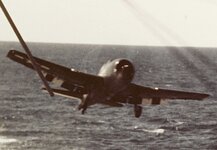This thread topic could have gone to other locations on this website, but I figured this was the best option.
We all know of the famous invasion stripes for the invasion of France, but what about the proposed invasion of Japan? I'm especially interested in how it would have worked with glossy sea blue USN aircraft. Does anyone know if concrete instructions are out there? If you did a what-if model for Operation Downfall, what did you do? A what-if forum that I found elsewhere discussed many colors, but nothing but guesses.
For reference, glossy sea blue Hellcats from VOF-1 and VF-74 participated in the invasion of Southern France in August 1944. The only marking I have seen was one VOF-1 aircraft with small white invasion stripes on the underside of its flaps (pic attached, credit USN). Contrary to multiple sources, I do NOT think they had red cowl rings in VOF-1. VF-74 looks to have had nothing but regular markings.
Then we have the 1945 Japan markings: yellow cowl rings used by at least a couple air groups for the initial Tokyo strikes and the invasion of Iwo Jima in February, as well as the white cowl rings for the initial Kyushu strikes in late March and maybe these lasted for the beginning of the Okinawa invasion.
So what do we think? I'm leaning towards white stripes at least on the wings (two or three?), and maybe white cowl rings. I don't think there is any document out there outlining official marking instructions. Let us discuss! Thanks!
We all know of the famous invasion stripes for the invasion of France, but what about the proposed invasion of Japan? I'm especially interested in how it would have worked with glossy sea blue USN aircraft. Does anyone know if concrete instructions are out there? If you did a what-if model for Operation Downfall, what did you do? A what-if forum that I found elsewhere discussed many colors, but nothing but guesses.
For reference, glossy sea blue Hellcats from VOF-1 and VF-74 participated in the invasion of Southern France in August 1944. The only marking I have seen was one VOF-1 aircraft with small white invasion stripes on the underside of its flaps (pic attached, credit USN). Contrary to multiple sources, I do NOT think they had red cowl rings in VOF-1. VF-74 looks to have had nothing but regular markings.
Then we have the 1945 Japan markings: yellow cowl rings used by at least a couple air groups for the initial Tokyo strikes and the invasion of Iwo Jima in February, as well as the white cowl rings for the initial Kyushu strikes in late March and maybe these lasted for the beginning of the Okinawa invasion.
So what do we think? I'm leaning towards white stripes at least on the wings (two or three?), and maybe white cowl rings. I don't think there is any document out there outlining official marking instructions. Let us discuss! Thanks!

